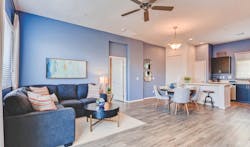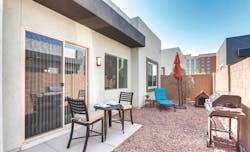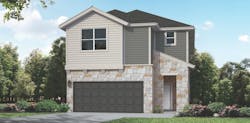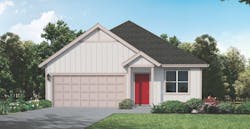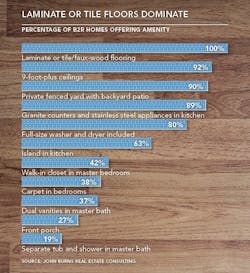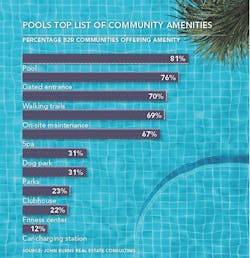Momentum Builds for Build-to-Rent
The single-family rental (SFR) market is hotter than ever. A new business model called build-to-rent, or B2R, is emerging, as developers create entire communities of newly built, detached rental homes. Often the amenity package at these communities rivals that of traditional single-family for-sale neighborhoods. It’s a trend that is projected to continue as consumers struggle with higher interest rates, higher home prices, and a limited supply of homes for sale. Or simply prefer to rent.
According to John Burns Real Estate Consulting, in Irvine, Calif., key players in the B2R sector include AHV Communities, Christopher Todd Communities, Invitation Homes, NexMetro Communities, and Progress Residential. John Burns analyzed 50 active and planned build-to-rent communities consisting of more than 6,000 homes, in order to rank the most frequently provided interior and community amenities.
Gene Kim, VP of asset management for Irvine-based AHV Communities, says that renting a detached home is attractive for many of the same reasons as renting an apartment: the portability/flexibility of a lease, no exterior maintenance, and no mortgage debt. A single-family home offers more space and privacy, with a backyard, attached garage, and other features not available in multifamily housing.
“Multifamily is vertical, with neighbors above and below you, and it’s noisy,” says Todd Wood, CEO of Christopher Todd Communities (CTC), in Phoenix. “With single-family, you have none of those acoustical issues.”
SFR, which had its genesis in Arizona, is now “bleeding out to the rest of the United States,” Wood says. “There is a lot of B2R in the Sun Belt, but it’s moving across the country.”
Mungo Homes, of Irmo, S.C., recently purchased by Clayton Properties Group, reports that activity in its Palmetto Residential Rentals division has increased. Palmetto is active in the Columbia, Greenville/Spartanburg, and Sumter markets of South Carolina. “In 2012 we leased a total of 56 homes,” says Palmetto’s Kym Johnson, director of property management/broker in charge. “Year to date [in 2018], we leased 84.”
The company recently added a selection of homes featuring larger, more affordable floor plans. Upgrades such as granite countertops, stainless steel appliances, and speaker systems have been incorporated.
And since 2012, Mungo’s rental homes also have included the company’s hauSmart energy-saving features, such as advanced framing, R-38 (R-50 in North Carolina) ceiling insulation, and radiant-barrier roof sheathing.
Unlike exclusively B2R communities, Palmetto continues to mix rental homes into traditional for-sale neighborhoods. “We discontinued our lease-to-purchase program years ago since we weren’t seeing many convert to sales,” Johnson says.
Changing demographics over the last three decades have resulted in people marrying later and having children later, if at all, says Josh Hartmann, president and COO of NexMetro Communities, in Phoenix. “They don’t want to be tied down to a mortgage,” Hartmann says.
Or, as Wood puts it, “The American Dream is changing. The last recession hurt a lot of people, and homeownership is at a 20-year low.”
Most single-family renters fall into one of two categories: Baby Boomers who are downsizing, or Millennials. The latter, says Wood, are saddled with large amounts of student-loan debt and either can’t or won’t buy a home. Renting affords them a more mobile lifestyle. The same goes for Boomers who lost their homes to foreclosure during the recession and are gun-shy about purchasing another.
SFR satisfies these renters’ needs in a single-family home, and takes care of the exterior maintenance, to boot. Notes Kim, “It’s a unique lock-and-leave, managed experience more akin to the apartment world,” with detached-home benefits.
B2R communities tend to lease quickly. AHV rents 12 to 20 homes per month during peak season (April through August), and eight to 10 per month during the rest of the year. According to John Burns, the homes can rent at significant premiums—anywhere from 15 to 30 percent above equivalent-size apartments or “one-off” single-family rental homes located in traditional for-sale neighborhoods.
Identifying Build-to-Rent Submarkets
Most SFR communities are on the outskirts of real-estate submarkets such as Carrollton, Texas, and Mesa, Ariz., close to transportation corridors, employment, good schools, retail, and other amenities and services. Wood and Hartmann say it’s important to understand local demographics and the product and design elements that attract renters.
Durable, low-maintenance materials, and small spaces that feel large and private, are critical because they translate not only into consumer satisfaction but they also save on operating costs. Another key, Hartmann says, is to partner with a property management company that can provide high-quality maintenance and repair services.
John Burns has identified two B2R business models:
• Full-service, where on-site leasing experts are supported by up to three model units. Services include property management, 24-hour maintenance, lawn service, and a trash valet. Amenities may include gated entrances, private streets, pools, and parks.
• Minimal B2R model, which is akin to a traditional single-family detached neighborhood with virtually no amenities or on-site services.
The B2R companies interviewed for this article are focusing on the full-service model. For example, in fast-growing San Antonio, AHV is developing a community called Pradera that will encompass 250 homes plus a clubhouse with Wi-Fi, café-style working areas, a community kitchen, a pool, a fitness center, a dog park, and walking trails.
NexMetro’s Avilla communities are pet-friendly and include a resort-style pool and spa, a covered ramada, walking paths, optional garages, and an electric-car–charging station. Surveys show that Avilla residents rank high-speed Internet as one of the most important factors in their housing decision, so NexMetro integrates the highest available Internet speeds. “In Phoenix, all of our communities have Cox Gigablast, which provides speeds of up to 1 gigabit,” Hartmann says.
CTC includes pet doors in all of its homes. The pool, exercise facilities, and planned social activities bring residents together, Wood says, which doesn’t always happen in apartment buildings. And technology also is important: Homes have high-speed Internet, keyless entry, and tablet-controlled security, climate control, and entertainment systems. “Our B2R product is driven by technology,” Woods says. “There are ‘smart’ front gates at all of our communities.”
Branded Build-to-Rent
NexMetro builds what Hartmann calls “a single-family rental hybrid. We’re a multifamily developer that happens to build small detached homes,” he says. The company has developed B2R communities in Dallas, Denver, and Phoenix. And it recently opened Arizona projects in Mesa, Goodyear, and southwest Phoenix, bringing the total number of NexMetro communities in the area to nine. All of them offer the Avilla branded product line, which ranges in size from 650 to 1,250 square feet.
The single-level homes have one to three bedrooms, 10-foot ceilings, open floor plans, and private backyards. Garages are optional. The homes are located in “mini” master planned communities of 120 to 150 houses. “We get certificates of occupancy as we’re building and we move people in within three to six months,” Hartmann says.
NexMetro is aware prospective renters expect a certain level of finish, “so we try to be current,” he says. “We’ve switched from granite countertops to quartz.” Stainless steel appliances and resilient flooring are included, and all homes are Energy Star rated.
Like NexMetro, CTC wants to brand its homes to make them recognizable in any market. Smart technology is an important pillar for the company because 50 percent of renters are tech-loving Millennials and 35 percent are Boomers who desire a lock-and-leave lifestyle, Wood says, adding, “Their average annual income is $80,000 to more than $100,000, so they’re renters by choice.”
SFR communities typically lease three to five times faster than traditional multifamily housing, Wood says. “We have strong pre-lease periods, often ending up with waiting lists. [All of the homes are rented] in three to four months, versus 10 to 14 months for multifamily.”
There are signs that build-to-rent’s appeal is expanding beyond Millennials and Boomers. Hartmann says NexMetro renters have begun to include more seniors, retirees, and young Gen Xers: “They’re second-generation adopters.”


